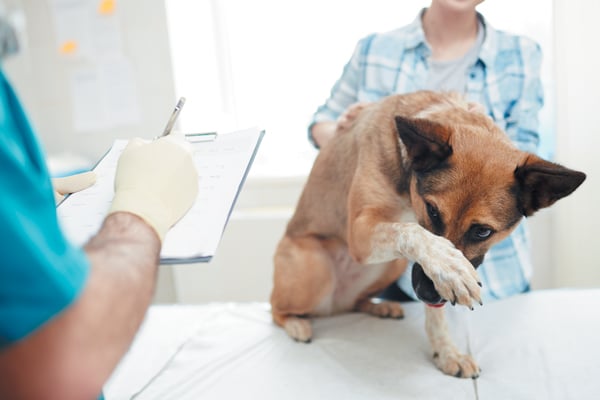If you think about what happens routinely to your dog at the veterinarian’s office — temperature checks up the bum, strangers touching him all over, stress sounds and smells coming from other animals nearby, painful shots, blood draws, etc. — it’s not surprising that dogs often don’t enjoy vet visits.
How can dog parents and veterinarians help dogs relax more for these all-important visits? It requires both the pet parent and the veterinarian to make a big cultural change, and it is a change that is badly needed.
Tips for pet parents

calm canine behavior with mind-blowing treats and praises. Photography ©BraunS | Getty Images.
I have talked with countless trainers and veterinarians across the country about what they need from owners to not only keep the waiting room safe for all but how to assist their dog while at the vet’s office. We trainers talk every day about how stressful it can be for dogs to make a routine office visit.
Here are the top things trainers and veterinarians tell me they wish pet parents would do:
1. Properly restrain your dog on a short leash. Do not bring your dog in on a retractable leash that allows him to roam the waiting room, not only stressing other dogs and cats there (who are likely already stressed themselves), but also potentially knocking down children or elderly people. There are also health considerations for all, as your dog — or the one he is investigating — might very well have something contagious.
2. Socialize him to public situations. If your dog lives between your home’s four walls and never ventures to new places, of course going to the vet’s office may very well be terrifying. Start early, as the dog brain forms opinions of the world very early in life. Make the public outings enjoyable and safe for your pup. It’s never too late to start, but the earlier you provide proper socialization for your dog, the better.
3. Prepare your dog to be handled by a stranger. Your dog isn’t seeing the vet technicians and veterinarian every week, so those handling him are, in effect, strangers. A scared dog might bite those handling him, and vet techs have to hold your dog still for examinations, shots, etc. Imagine if you went to the doctor’s office and a nurse stood over you and held your arms and legs down! You’d probably feel trapped.
At home, practice having a friendly person lean over your dog while you are reinforcing calm canine behavior with mind-blowing canine treats. Go slowly. Touch your dog’s nails, feet, ears and back while telling him what a good boy he is and while feeding those yummy treats. Do this often — not just once a year!
4. If you have a reactive dog, call ahead and let the staff know you’ll wait out in your car until an exam room is available. Reactive dogs can be even more stressed than other dogs at the vet clinic. Alternatively, look for a veterinarian who makes house calls.
Tips for veterinarians
1. Provide visual barriers and small cubbyhole areas in the waiting room. The waiting room in many vet offices can quickly became a nightmare for dogs. A stressed dog is much more likely to bite out of fear.
2. Vet staff — often the heroic backbone of any clinic — must be trained in gentle handling and how to help ease canine worry and stress. It’s in the veterinarian’s best interest to keep their canine clients as calm and as happy as possible. Low-stress handling courses are readily available and, thankfully, becoming more and more popular.
3. Do away with waiting rooms altogether. Is this a radical idea or an extremely practical one that will help dogs enormously? More private rooms solve a lot of the waiting room stresses. As more and more dog owners ask for low-stress handling of their pets, why not provide a safe waiting room and low-stress handling for your clients?
It takes a caring and thoughtful pet parent to prepare their dog for a vet visit. It takes a wise veterinarian to learn how to limit stress while their canine customers are getting routine vet care.
Thumbnail: Photography ©shironosov | Getty Images.
Editor’s note: This article first appeared in Dogster magazine. Have you seen the new Dogster print magazine in stores? Or in the waiting room of your vet’s office? Subscribe now to get Dogster magazine delivered straight to you!
About the author
Annie Phenix, CPDT-KA, is a professional dog trainer based in Utah. She is a force-free trainer specializing in working with troubled dogs. She is the author of The Midnight Dog Walkers: Positive Training and Practical Advice for Living With a Reactive or Aggressive Dog. For more information, visit phenixdogs.com.





